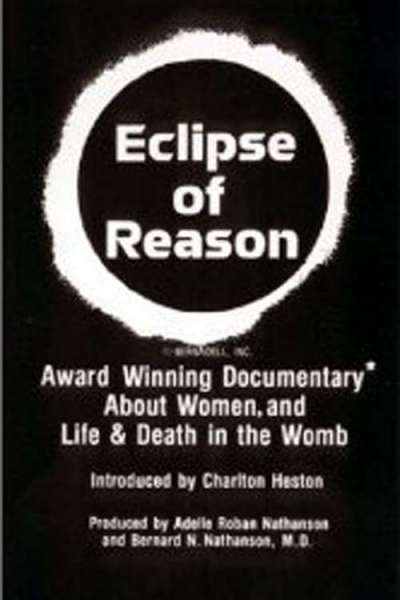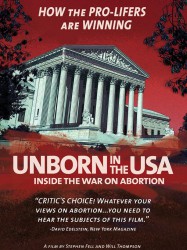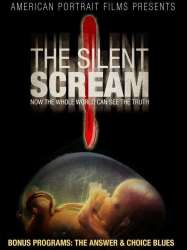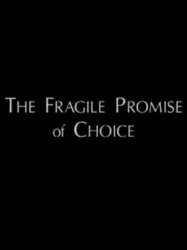Eclipse of Reason est un film américain de genre Documentaire avec Charlton Heston
Eclipse of Reason (1987)

Si vous aimez ce film, faites-le savoir !
Eclipse of Reason is a 1987 pro-life documentary video directed, filmed, and narrated by Bernard Nathanson, with an introduction by Charlton Heston. Eclipse of Reason is a follow up to Nathanson’s first film The Silent Scream. The film is perhaps most known for its controversial depiction of a dilation and evacuation (D&E) abortion. The subject matter of this film focuses more on the moral implications of abortion. It served as Nathanson’s call to the women of the world to end the practice of abortion. This film, as well as The Silent Scream, was instrumental in the Right to Life Committee's garnering the attention of the United States public regarding the issue of abortion.
Eclipse of Reason represented the argument that the fetus is human, and therefore abortion is murder, a belief in line with the pro-life movement. The film also serves to combat critics to The Silent Scream who argue that, although Nathanson claimed the film relied only on imagery and not pejorative speech, the film was heavily reliant on upon the language of the narrator. Therefore, Eclipse of Reason delivers the same message that abortion is murder, with similar imagery as its predecessor The Silent Scream; however, to avoid the previous appropriation of language over imagery Eclipse of Reason asks it viewers to consider reason rather than using emotionally charged narration.
Acteurs

Charlton Heston
(Narrateur)
Commentaires
Postez un commentaire :
Suggestions de films similaires à Eclipse of Reason
Il y a 75 films ayant les mêmes acteurs, 8965 ayant les mêmes genres cinématographiques, 9915 films qui ont les mêmes thèmes (dont 14 films qui ont les mêmes 4 thèmes que Eclipse of Reason), pour avoir au final 70 suggestions de films similaires.Si vous avez aimé Eclipse of Reason, vous aimerez sûrement les films similaires suivants :

While I Run This Race (1967)
Réalisé par Edmond Levy
Origine Etats-Unis
Genres Documentaire
Thèmes Documentaire sur une personnalité
Acteurs Charlton Heston
Note62%






180 Movie (2011)
, 33minutesOrigine Etats-Unis
Genres Documentaire, Fantasy
Thèmes La grossesse, Sexualité, Documentaire sur une personnalité, Documentaire sur la santé
Note53%





Le film commence sur des images de l'Holocauste et se termine en indiquant que plus de 50 millions d'avortements ont eu lieu à ce jour aux USA : l' « Holocauste américain ».

Live Free or Die (1999)
, 1h10Genres Documentaire
Thèmes La grossesse, Sexualité, Documentaire sur une personnalité, Documentaire sur la santé
Note71%





 , 1h45
, 1h45Origine Etats-Unis
Genres Documentaire
Thèmes La grossesse, Sexualité, Documentaire sur une personnalité, Documentaire sur la politique, Documentaire sur la santé, Politique
Note63%





Il relate les événements majeurs tels que la marche annuelle pour la vie de Washington et la marche pour la vie des femmes.

Spin (1995)
, 56minutesGenres Documentaire
Thèmes La grossesse, Sexualité, Documentaire historique, Documentaire sur une personnalité, Documentaire sur la politique, Documentaire sur la santé, Politique
Acteurs Jon Voight, Larry King
Note78%





 , 1h30
, 1h30Origine Etats-Unis
Genres Comédie, Documentaire, Romance
Thèmes La grossesse, Sexualité, Documentaire historique, Documentaire sur une personnalité, Documentaire sur la politique, Documentaire sur la santé, Politique
Note61%





The documentary highlights the lives of people in Middle America, Central United States small town or suburb where most people are middle class, Protestant, and white, which twice helped elect George W. Bush. The movie shows how Kansas, once home to left-wing movements like the Populist Party, became very socially conservative in the late 20th century.

Le Cri silencieux (1984)
, 28minutesOrigine Etats-Unis
Genres Documentaire
Thèmes La grossesse, Sexualité, Documentaire sur une personnalité, Documentaire sur la santé
Note51%





Dans ce film, Bernard Nathanson, ancien avorteur repenti, sert à la fois d'expert médical et de narrateur. Il décrit les événements de l'avortement « du point de vue de la victime ». Le film compile une série d'images floues de nature échographique. Nathanson montre au grand public les instruments utilisés pour un avortement typique et prétend que la tête, même à la gestation de 12 semaines, sera trop grande pour entrer dans le dispositif d'aspiration ; il montre alors comment les forceps sont utilisés pour écraser le crâne, où les ondes cérébrales, d'après lui, ont été actives pendant six semaines.
 , 28minutes
, 28minutesRéalisé par Dorothy Fadiman
Origine Etats-Unis
Genres Documentaire
Thèmes La grossesse, Sexualité, Documentaire historique, Documentaire sur une personnalité, Documentaire sur la santé
Note67%






After Tiller (2013)
, 1h27Origine Etats-Unis
Genres Drame, Documentaire
Thèmes La grossesse, Sexualité, Documentaire sur une personnalité, Documentaire sur la santé
Note73%





The film follows the daily work and lives of doctors LeRoy Carhart, Warren Hern, Shelley Sella, and Susan Robinson, the only four doctors in the United States who openly perform late-term abortions after the 2009 assassination of Dr. George Tiller.
 , 57minutes
, 57minutesRéalisé par Dorothy Fadiman
Origine Etats-Unis
Genres Documentaire
Thèmes La grossesse, Sexualité, Documentaire historique, Documentaire sur une personnalité, Documentaire sur la politique, Documentaire sur la santé, Politique
Note66%





 Connexion
Connexion